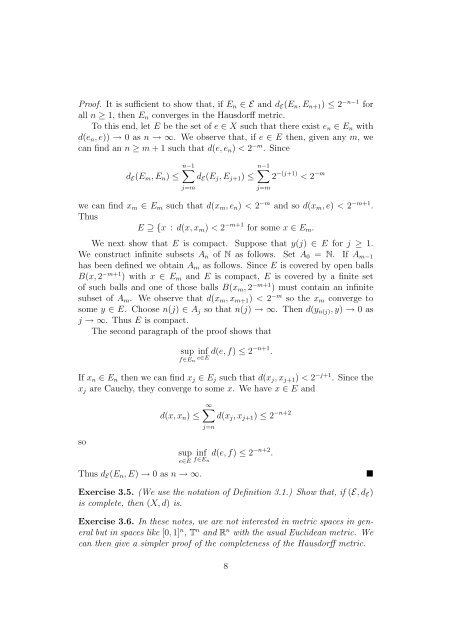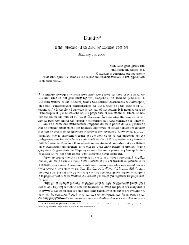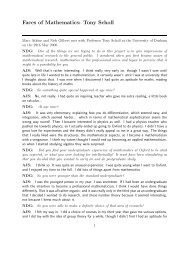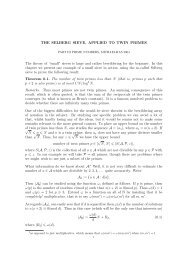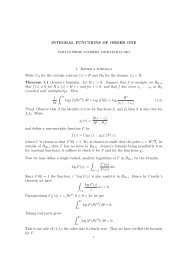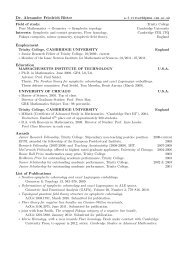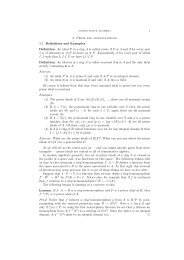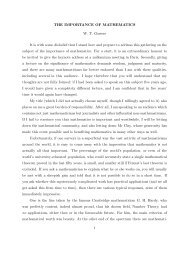Baire Category, Probabilistic Constructions and Convolution Squares
Baire Category, Probabilistic Constructions and Convolution Squares
Baire Category, Probabilistic Constructions and Convolution Squares
You also want an ePaper? Increase the reach of your titles
YUMPU automatically turns print PDFs into web optimized ePapers that Google loves.
Proof. It is sufficient to show that, if En ∈ E <strong>and</strong> dE(En,En+1) ≤ 2 −n−1 for<br />
all n ≥ 1, then En converges in the Hausdorff metric.<br />
To this end, let E be the set of e ∈ X such that there exist en ∈ En with<br />
d(en,e)) → 0 as n → ∞. We observe that, if e ∈ E then, given any m, we<br />
can find an n ≥ m + 1 such that d(e,en) < 2 −m . Since<br />
n−1<br />
dE(Em,En) ≤<br />
j=m<br />
<br />
n−1<br />
dE(Ej,Ej+1) ≤ 2 −(j+1) < 2 −m<br />
we can find xm ∈ Em such that d(xm,en) < 2 −m <strong>and</strong> so d(xm,e) < 2 −m+1 .<br />
Thus<br />
E ⊇ {x : d(x,xm) < 2 −m+1 for some x ∈ Em.<br />
We next show that E is compact. Suppose that y(j) ∈ E for j ≥ 1.<br />
We construct infinite subsets An of N as follows. Set A0 = N. If Am−1<br />
has been defined we obtain Am as follows. Since E is covered by open balls<br />
B(x, 2 −m+1 ) with x ∈ Em <strong>and</strong> E is compact, E is covered by a finite set<br />
of such balls <strong>and</strong> one of those balls B(xm, 2 −m+1 ) must contain an infinite<br />
subset of Am. We observe that d(xm,xm+1) < 2 −m so the xm converge to<br />
some y ∈ E. Choose n(j) ∈ Aj so that n(j) → ∞. Then d(yn(j),y) → 0 as<br />
j → ∞. Thus E is compact.<br />
The second paragraph of the proof shows that<br />
j=m<br />
sup inf<br />
f∈En<br />
e∈E d(e,f) ≤ 2−n+1 .<br />
If xn ∈ En then we can find xj ∈ Ej such that d(xj,xj+1) < 2 −j+1 . Since the<br />
xj are Cauchy, they converge to some x. We have x ∈ E <strong>and</strong><br />
so<br />
d(x,xn) ≤<br />
sup<br />
e∈E<br />
inf<br />
∞<br />
d(xj,xj+1) ≤ 2 −n+2<br />
j=n<br />
f∈En<br />
d(e,f) ≤ 2 −n+2 .<br />
Thus dE(En,E) → 0 as n → ∞. <br />
Exercise 3.5. (We use the notation of Definition 3.1.) Show that, if (E,dE)<br />
is complete, then (X,d) is.<br />
Exercise 3.6. In these notes, we are not interested in metric spaces in general<br />
but in spaces like [0, 1] n , T n <strong>and</strong> R n with the usual Euclidean metric. We<br />
can then give a simpler proof of the completeness of the Hausdorff metric.<br />
8


